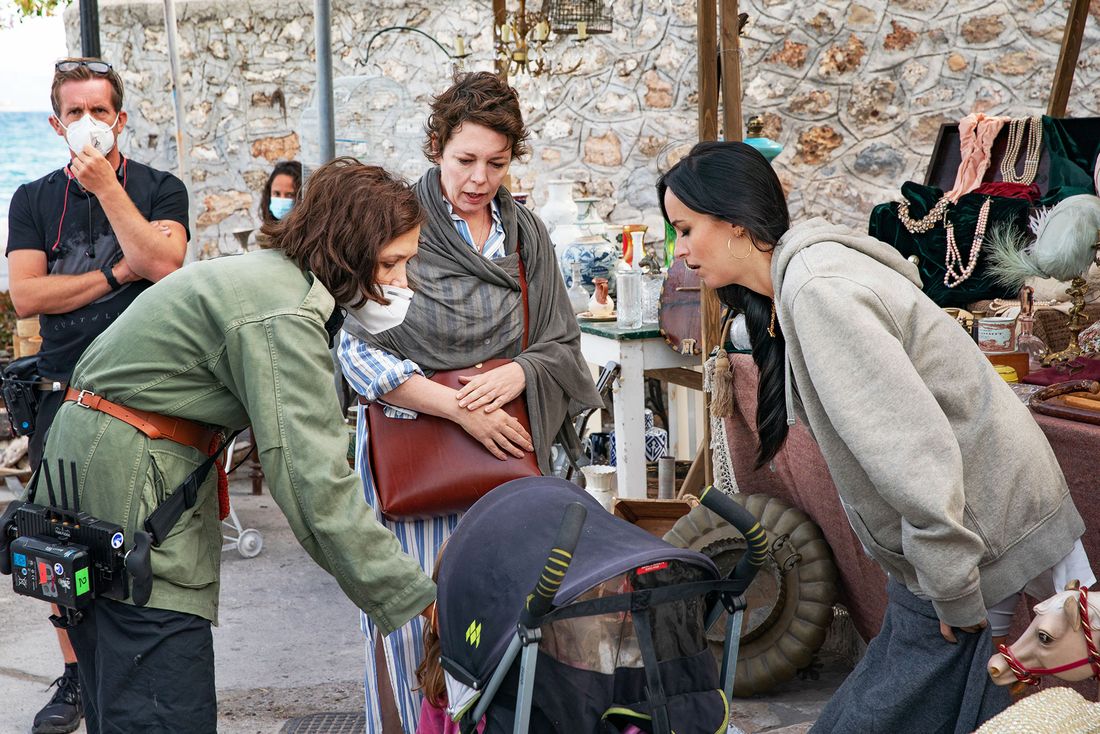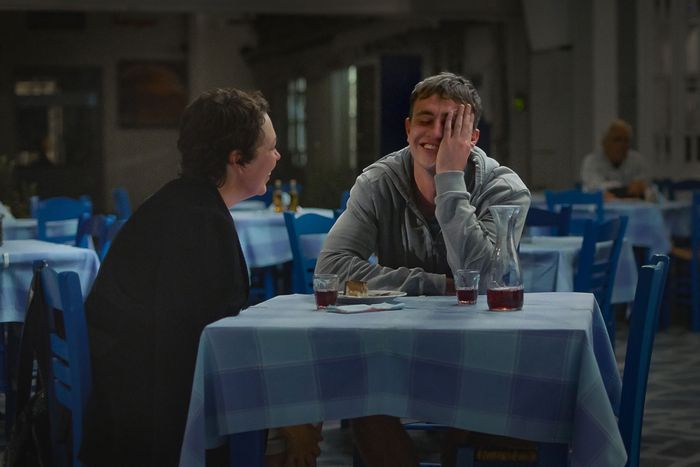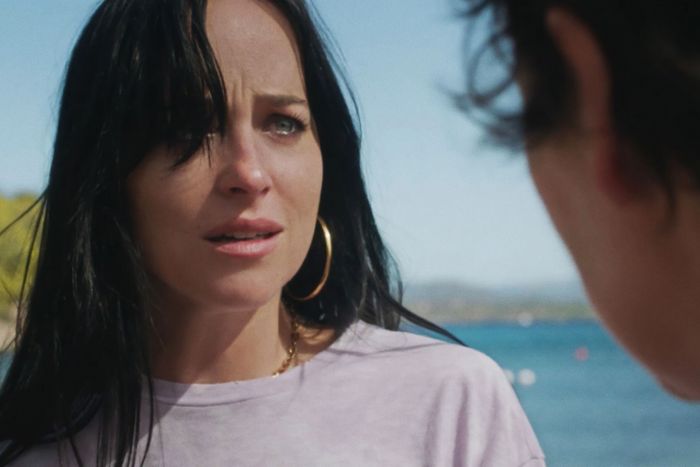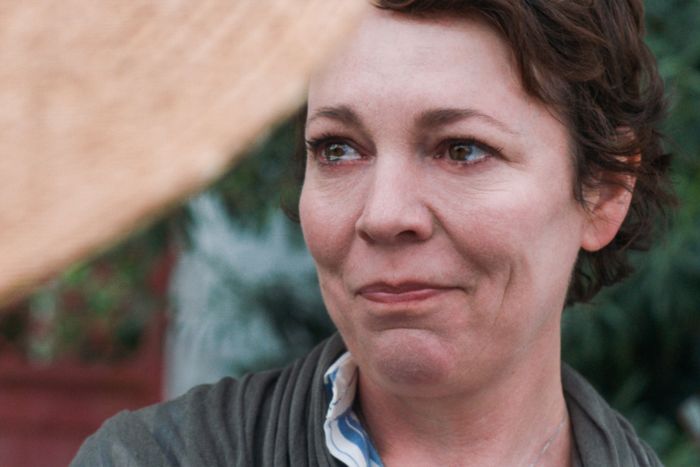
Maggie Gyllenhaal’s film of Elena Ferrante’s The Lost Daughter is conversation-piece cinema — the kind of movie that audiences see and then argue about. Tenderhearted but also elliptical and mysterious, it gives viewers the mental space to form their own answers to questions it raises and then leaves hanging: Is our heroine, a Harvard professor named Leda (played in her 40s by Olivia Colman and as a young woman by Jessie Buckley), a bad mother or disturbed person for having left her children when she was younger and then returned to them? Why does Leda become fixated on another young mother (Dakota Johnson’s Nina) during a beach vacation in Greece? And were the various outrages, accidents, and acts of emotional and physical violence depicted in the film avoidable or inevitable?
Gyllenhaal’s writing and directing are bold — particularly her decision to adapt a first-person novel as a third-person movie that grants us no access to Leda’s mind. Her work is now Oscar-nominated for Best Adapted Screenplay. We talked to Gyllenhaal about what happens when a mother’s sacred duties crash headlong into the reality of human frailty and how she went about translating that collision onscreen.
Can you tell me about how you decided not just to adapt Elena Ferrante’s The Lost Daughter but to make it your feature directorial debut?
To be honest, originally it was a different book of hers that I wanted to adapt, Days of Abandonment. The rights were unavailable, so I was asked to consider The Lost Daughter instead. I read it in a weekend and said, “The story is not the same, but the point of wanting to tell it, the unconscious conversation, is the same, so yeah, I can do it.” Ferrante, in all of her work, is so uncompromisingly honest about things that we really don’t talk about and have agreed not to talk about. She breaks the agreement, and it feels like the shattering of something.
My one reservation was the 20-year age gap between the two versions of the heroine and how to solve that cinematically. Obviously in a book, you can do whatever you like. Cinematically, it was a risk.
Which you solved by casting Olivia Colman and Jessie Buckley as the older and younger versions of the main character. But I wonder, since the novel is written in first-person, why did you decide not to go with any of the usual devices for adapting a first-person novel, specifically voice-over narration?
It never occurred to me to use a voice-over, actually. There are some movies where voice-over is fascinating and works really well, but there are so many others where it doesn’t work well at all.
What would you say is the biggest challenge involved in adapting a first-person novel in a way that does not grant us direct access to the main character’s thoughts through voice-over?
The challenge is having to ask myself, “What is the event of this scene in the book? What is its purpose in the storytelling? And how do I express that purpose as non-literally as possible? How do I express it with as few words as possible?” Certainly not with words that ever say what the event is.
I’m compelled by the challenge of how can you use as few words as possible. Even in the scenes where there’s tons of talking in my movie, like when Olivia talks and talks and talks to Will, the young student played by Paul Mescal — without the voice-over, she’s not ever saying what the scene is about. She’s saying 40 other things that are up here [points to her forehead] in order to articulate one thing that’s at the center of it all.
It’s interesting that you mention all this because one of the moments I wanted to ask you about is when Will asks Leda, “Do you watch films in languages you don’t understand without the subtitles?” At the moment he says it, I thought, I feel like I’m watching a film in a language I don’t understand without the subtitles. Which is a compliment to your movie. I do this same thing myself with international films sometimes because I’m curious to see how much I can pick up from the acting and filmmaking if I don’t know the language.
I just watched Krzysztof Kieślowski’s The Decalogue. I had never seen it before. I didn’t see all of them. I jumped around in the order. I watched parts one, two, six, and nine, and at one point, I think it was during part nine, I realized that it had been like 25 minutes that I’d been watching this movie, and there’d been maybe five lines of dialogue. And they were all like, “Do I have any packages?” “No, sorry ma’am.” Or, “I’d like to apply for the job of the milkman!” All the storytelling was told inside of the filmmaking. I think that’s what I aspire to.
In the opening of the film, you have six minutes and 55 seconds of almost total silence — until the point when Leda collapses on the beach and the main part of your story finally kicks in. That’s a long time to go at the very beginning of a movie without a main character declaring who they are.
It’s a fine line to walk, right? In the movies I like, you’re going, “Okay, where am I? Who are you? How am I supposed to relate to you? How do you relate to these other people? Do I like you? Do I not?”
The way you’ve chosen to do it here turns the viewing experience into something more like a detective story. “What is her deal?” is the question I kept asking during that opening section. You finally do get around to telling us what Leda’s deal is, but nothing is handed to us.
Do you know Gomorrah, by Matteo Garrone?
I love that movie. I went to see it knowing almost nothing about it, and it turned out to be absolutely the right way to experience Gomorrah.
You’re like, “Wait, who is that? What’s he doing? How is he related to … I don’t understand!” But you’re so compelled to try and figure it out. But then again, sometimes you see movies like that and you think, I don’t care. I’m so lost that I don’t care. How do you walk that line? How do you make people care and want to do the work to understand who the people in the film are?
What sorts of filmmaking choices did you make in order to further your goal as a storyteller?
I did not have a dogma. There were some intellectual ideas that I was thinking about and working with, but I think most of the aesthetic work — in terms of how we lit it and how we moved the camera and where we put the camera and why — came from my director of photography Helene Louvart and I doing the same kind of work that I would do as an actress.
What kind of questions are you asking yourself when you direct that way?
“What is this scene about, in the most spiritual way?” And then, “How do we express what it’s about?” It can have an ease to it if we agree on what it’s about. For example, the incredible scene where Olivia’s in the flea market, where she actually does finally tell you, as you put it, what’s her deal. That scene — I would call it the event of that scene — is revealing a secret. It’s constructed in a way that it could be expressed 400 different ways and all of them would be okay. In fact, it was expressed many, many different ways. There were times when Olivia was totally impassive, there were times when she was full of rage. And all of them told the story.
It’s funny, we did tons of shot listings with Helene. She asked me questions about light. It turns out I have very strong feelings about light! I’d realize, Oh, I totally see the scene in my head. But then it changes when you get to the location. Instead of it being an imaginary place, you’re in a real place. And it changes again of course when you have real human beings there. I had this folder of all these shot lists, and I never once cracked the folder while we were shooting. I said, “Helene, I’m an actress. I am never going to tell Ed Harris and Olivia Colman, ‘Before you got here, alone in my room, I decided that you’re gonna start at the bed and on this line you’re gonna walk to the door.’”
Despite already having made lists of shots ahead of time?
We were playing jazz the whole time. We were moving and shifting, and we really came up with a visual language together. There were a couple days we budgeted for a Ronin operator, which is a camera that’s like a Steadicam. But when the operator arrived, I was like, “This is wrong. Where’s my movie? This does not feel like my movie anymore!”
What was wrong with it? Was it too smooth?
It was not Helene! She’s another character in the film, to the point where it’s almost as if someone came in and played Olivia’s character Leda for a minute.
So you’re thinking of these spectacular moments in your head, and then when it comes to shoot, you change direction and pare it back and make it simpler?
Let me give you some concrete examples. I got like a $50,000 price tag for staging the car accident Leda gets into at the beginning. I was like, “Fuck it. I don’t need to see the car accident.” I thought that the audience imagining Leda’s minor car accident was going to be much more interesting than anything we could create on a small budget. What I do care about, and what I want to budget for being able to shoot, is a five-page-long dialogue scene in a flea market and being able to film the scene from start to finish every time.
Why start to finish as opposed to breaking it into pieces?
Because I never want to ask Olivia Colman or Dakota Johnson to turn on their mark and say, “I left my children for three years,” you know? That’s shitty. They’re both great actresses, and they both could have done it, but it limits expression. Filming it in a way where they could do the entire thing all the way through a few times was where I wanted to put my money.
So anyway, back to the Ronin. I was like, “Helene, I just want you to shoot it.” She doesn’t want to. She says it’s going to look like an elephant is holding the camera. I said, “I don’t care. I want you to shoot it.” So she shoots, and all of a sudden we have this beautiful image of Olivia weeping with Dakota’s hat obscuring half of her face. It’s almost like you want to turn your head to see more and you can’t. And all of a sudden I was like, “There. That’s my movie.” That’s really how we worked.
When Leda’s on the beach in the first section of the movie, all of the shots of her looking at other people reminded me a little bit of Rear Window, where he’s looking out at the different apartments in the courtyard of his complex, and every vignette in each apartment represents some aspect of his own problems.
I was thinking about how so many compelling women have been adored and observed on film. Not the stupid version of that — I’m not as interested in objectifying fantasies and sexuality. But I was drawn to Michelangelo Antonioni and Jean-Luc Godard, or Federico Fellini, and who their women were that were fundamentally interesting. So much of the beginning of the film, Dakota’s being adored and observed. There’s a lot of people watching; Olivia’s Leda does a lot of watching in the film. There’s a tradition of films about people watching and being watched, and the film itself is about the act of watching.
But I also wanted to know what happened after we get comfortable in a language of how we look at her and are compelled by her. What if, after that, she bursts into the frame and has not just a voice, but a really strong need and a hunger that’s bigger than what we’re expecting?
Objects and props are often important tools to help actors focus and clarify their performances. And wow, do we have a fantastic selection in this film: A hat. A hatpin. Dolls. Several oranges that peel like a snake. You keep coming back to these objects over and over, examining them from different angles. In many cases, there are different actors and sometimes different configurations of actors interacting with them. What can you tell me about the meaning and use of these objects?
I remember Jeff Bridges in a great scene in Crazy Heart where he was frying fish while he’s on a call with my character. I watched him decide what to do ahead of the shoot. It was brilliant. “Guys, I need fish, and I need bread crumbs, and I need this and this.” All of a sudden, Jeff has an obstacle in a scene where there wasn’t much of an obstacle. It’s so much better as an actor to create for yourself, “Fuck, okay, he called, but I’ve got the stew on, and I’m frying an egg. Shit, it’s burning. ‘Yeah? Yeah? Hi?’”
Part of your job as an actor is to create the circumstances. Where are you coming from? Where have you just been? Where are you going? What do you need? What’s in your hands? When I write, I often try to create those kinds of circumstances to begin with. But having been an actress, and having spent so much of my energy keeping my ideas close to the vest because sometimes people feel challenged by them, I wanted to create a set where nobody had to keep their ideas to themselves — where there was space for them. And some of the most beautiful things in the movie came from my actors.
I didn’t feel there was some sort of Chekhovian function to the hatpin. I didn’t feel that the peeling of the orange meant one specific, reducible thing to any of the characters that do it. Forgive me if you intended for them to and I just missed it. But I didn’t feel like I was watching that sort of a movie.
In your life, does one thing that’s important to you explain everything about you? No! But maybe there is some reason you’re drawn to something for a while and repelled by something else. It does have a meaning, it does have an importance, but it’s not analyzable in a rational way. It’s much more a conversation of the unconscious.
Maybe this is the point where we dive into the unspeakable. I’m a parent to five. I think it takes guts to do a movie like this because there’s tremendous pressure on parents to reassure everybody they know that, at any given point during the day, being a parent is the single most important thing to them and they love every second of it. To put it mildly, your movie doesn’t endorse that.
I think it’s an unreasonable expectation. In my experience, having children is the biggest thing that has ever happened to me. I would say “the most challenging,” but that implies only difficulty. There’s no way to come to parenting as anything other than a total beginner. I believe that parenting is designed to bring us to our knees and to grow us as much as it’s designed to grow them.
The film is trying to be friendly and say it’s okay! The despair, the anxiety, the terror, the feeling of real crushing responsibility along with a kind of heart-wrenching ecstasy, a joyfulness that we couldn’t possibly have anticipated — all of it is within the spectrum of “normal.” And even though it will be painful to look at some of these things, we’re here for you. We’re here with you.
It’s funny, early on, I remember one of my producers showed the movie to a friend of hers who said, “Does she have to take the doll?”
Oh my god!
I recount that just to say, “Look, we’re choosing a very challenging heroine! We’re choosing someone who does the most aberrant, transgressive thing! We’re choosing somebody who doesn’t just throw a doll out the window, which is really hard to reconcile in itself, but who leaves.” And yet, even if we ourselves would never leave, what an interesting proposition: to offer the opportunity to relate to her and see how you feel.
The scene where young Leda throws the defaced doll out the window feels more violent to me than most of the things I see in horror movies because it shows, basically, an everyday unspeakable impulse realized.
My husband said a really funny thing. He said, “Did people ask about the likability of Robert De Niro’s character in Taxi Driver?” “But it’s different,” I told him, “because Travis Bickle is mentally ill. We’re not him. Whereas what I’m asking of people is to relate to somebody who has done things that cause her and, we assume, her children almost unbearable pain. Can you relate to this person? Can you be brave enough to consider that you might have some ways of relating to her?” You know? It’s dangerous!
And to further complicate that, she doesn’t leave her children forever. She leaves her children and then comes back. And yet the damage inflicted by the leaving is still immense.
It’s very complicated. I think in terms of film in particular, but also all sorts of other fictionalized depictions of mothers, we have mostly seen a monstrously bad mommy or an angelically good mommy.
“Climbing on the cross and nailing herself to it” mommy is a whole subgenre of motion pictures.
But to put them together and ask us to use our grown-up selves to say, “Probably my parents felt somewhat like I did, which was challenged and ambivalent and full of love and all sorts of things.”
From that standpoint, the climactic scene between Leda and Nina is fascinating in many ways, starting with how it’s staged. Leda is sitting in a high-backed chair that I would associate with a Freudian therapist, and yet she is confessing as well as asking questions. Two moments in the scene pierced me, and I want to ask you to talk about both of them. The first is when Nina asks Leda, referring to her unhappiness and turmoil, “Is this gonna pass?”
That’s not just about motherhood, it’s really about the experience of being a woman in the world in general. “Is this gonna pass?”
I also see Leda in that scene as a kind of therapist. She’s very removed. It was interesting because you’ve seen how deep Leda’s need is. She’s sleeping with the doll right before that! It’s massive — her need and her heat and her desire and her hunger. It’s not cool. It’s not cold. But then when we were reading the scene, Olivia just seemed a little cold. I thought that was really interesting, and I nudged her more and more that way. I added a line at a certain point, where Leda says, “Okay.” I didn’t tell her how to say it. I just said, “Let’s add the line ‘okay’ here, which means, ‘It’s time for you to go. Do you want the keys? If you want the keys, take the keys. If you don’t want the keys.’”
And then we cut in close on Olivia. I play almost the whole scene in more of a medium shot and then just at the end, we cut in close, and she says to Nina, “I have something else to give you.” People have also said to me, “Why doesn’t she just lie and say ‘I found the doll’?”
Maybe because she has an overwhelming need to confess? She feels terrible, not only about stealing the doll but also about incidents in the past?
And also she’s a hero! She’s really a hero. We meet her when she is basically in a life-or-death situation, metaphorically. Either she’s going to spend the rest of her life so anxious she can barely walk down the street without passing out or she’s going to get down into it and look at the darkest parts of herself. Always in those darkest hidden parts of ourselves, there’s a little bit of life. And she does it. She goes down into it. So of course she has to tell the truth that she took the doll.
And in fact, ultimately, she does tell Nina, “No, it doesn’t pass.” In some ways, I think — and I’m not sure Dakota thinks this, I have no idea — that’s why Nina stabs her with the hatpin. I think Nina stabs Leda because she wants it to pass, she wants it to get better. And the truth is, life is … that bit from The Princess Bride: “Life is pain, highness! Anyone who tells you differently is selling something!” Or at least, life includes pain. It doesn’t pass. You get better at living with both pain and pleasure.
The other line I wanted to ask you about is “I’m an unnatural mother.”
That’s a straight Ferrante lift.
That’s about as loaded as it gets, that line.
A couple of people who I really respect and who I took great notes from told me to cut that line. They said, “It’s too literary.” But I didn’t cut it because I don’t think it’s literal. I think it’s the opposite of literal. I think it’s an impossible puzzle that reverberates on itself. An unnatural mother implies that there’s such a thing as a natural mother, and I think the whole film is calling that into question. And at the same time, is every mother a natural mother, or is every mother an unnatural mother?
The line “It felt amazing” — when she says that she left her children — that’s also not meant to be taken literally either.
That’s a heavy moment.
I really love that moment because the thing is, she says, “It felt amazing,” which is not untrue. And at the same time, we’re watching someone throughout the entire film who was destroyed by this decision that she made. So how do you reconcile those things? Well, that’s the character. That’s a life. That’s an idea worth thinking about. That’s a person, I think, worth spending two hours with.
This interview has been edited and condensed.





